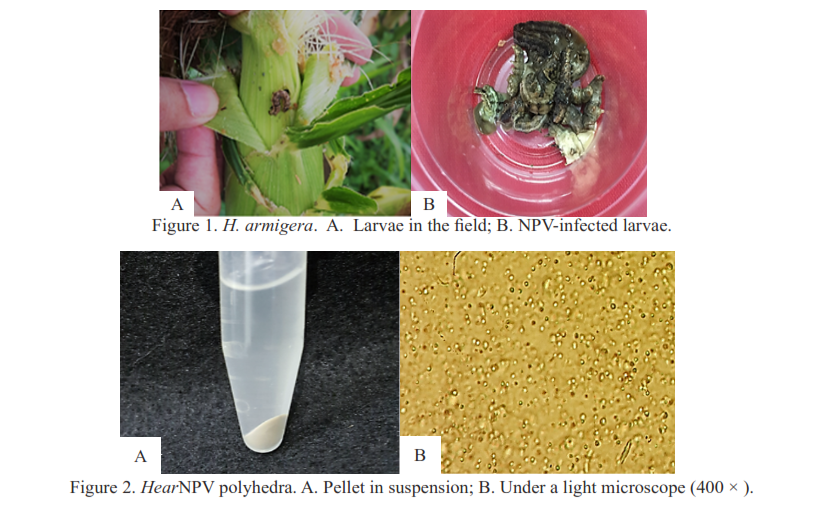Molecular characterization of Helicoverpa armigera Nucleopolyhedrovirus (HearNPV) on Helicoverpa armigera Hübner larvae (Lepidoptera: Noctuidae)
Main Article Content
Abstract
Nucleopolyhedrovirus (NPV) is a type of biological agent that can be effectively used as a bioinsecticide to control the cob borer caterpillar in corn. Among these viruses, HearNPV (Helicoverpa armigera Nucleopolyhedrovirus) stands out due to its host specificity, environmentally safety, and lack of harm to non-target organisms. The primary objective of this study was to elucidate the molecular characteristics of the DNA polymerase gene of HearNPV. To achieve this, caterpillars were collected from the field, then reared and inoculated in the laboratory under controlled conditions. Following propagation, viral genomic DNA was extracted using a modified CTAB (Cetyltrimethylammonium Bromide) protocol, which is commonly employed for its efficiency in isolating high-quality DNA from various sources. Subsequently, DNA amplification was performed using specific primers: forward primer HearNPV F and reverse primer HearNPV R. These primers were designed to target the DNA polymerase gene, a crucial component in viral replication and a key marker for phylogenetic studies. The results of the phylogenetic analysis indicated that the Bogor strains of HearNPV shared a high degree of similarity with NPVs that infect other species within the Helicoverpa genus, including strains from Spain, Australia, Brazil, Russia, and Japan. Specifically, the nucleotide sequence homology ranged from 98.4% to 99.4%, while the amino acid sequence homology ranged from 98.2% to 99.2%. This high level of homology suggests a close evolutionary relationship and potentially similar biological characteristics among these NPV strains.
Article Details

This work is licensed under a Creative Commons Attribution-NonCommercial 4.0 International License.
References
Arifin M. 2006. Kompatibilitas SlNPV dengan HaNPV dalam pengendalian ulat grayak dan ulat pemakan polong kedelai [Compatibility of SlNPV with HaNPV in controlling armyworms and soybean pod eating caterpillars]. Penelitian Pertanian Tanaman Pangan. 25: 65–71.
Cheng XW. 1998. Characterization of two nuclear polyhedrosis viruses from Thysanoplusia orichalcea (L.) (Lepidoptera: Noctuidae) from Indonesia. Dissertasion. Clemson University. South Carolina.
Criscuolo A & Brisse S. 2013. AlienTrimmer: A tool to quickly and accurately trim off multiple short contaminant sequences from high-throughput sequencing reads. Genomics. 102(5–6): 500–506. https://doi.org/10.1016/j.ygeno.2013.07.011
Dharmayanti NLPI. 2011. Filogenetika molekuler: Metode taksonomi organisme berdasarkan sejarah evolusi [Molecular phylogenetic: Organisms taxonomic method of based on evolution history]. WARTAZOA. 21(1): 1–10.
Doyle JJ & Doyle JL. 1990. A rapid total DNA preparation procedure for fresh plant tissue. Focus. 12: 13–15.
Fauquet CM, Mayo MA, Maniloff J, Desselberger U, & Ball LA. 2005. Virus Taxonomy, VIIIth Report of the ICTV. Elsevier/Academic Press. London.
Friesen PD & Miller LK. 1986. The regulation of baculovirus gene expression. Curr. Top Microbiol. Immunol. 131: 31–49. https://doi.org/10.1007/978-3-642-71589-1_3
Ginting S, Chozin M, & Sudjatmiko S. 2023. Infestation of Helicoverpa armigera (Hubner) and Ostrinia furnacalis Guenee on three tropical altitude variations. J. Trop. Plant Pests Dis. 23, (1): 31–37.
Grzywacz D. 2000. Control of insect pest with entomopathogenic viruses. Arab J. Pl. Prot. 18(2): 128–132.
Hall TA. 1999. BioEdit: A user-friendly biological sequence alignment editor and analysis program for Windows 95/98/NT. Nucleic Acids Symposium Series. 41: 95–98.
Hodgson DJ, Vanbergen AJ, Watt AD, Hails RS, & Cory JS. 2001. Phenotypic variation between naturally co-existing genotypes of a Lepidopteran Baculovirus. Evol Ecol Res. 3: 687–701.
Jackson TA, Crawford AM, & Glare TR. 2005. Oryctes virus—Time for a new look at a useful biocontrol agent. J. Invertebr. Pathol. 89(1): 91–94. https://doi.org/10.1016/j.jip.2005.03.009
Kalshoven LGE. 1981. The Pests of Crops in Indonesia. Translated by P. A. van der Laan. PT. Ichtiar Baru-Van Hoeve, Jakarta.
Mahmood TB, Hossan MI, Mahmud S, Shimu MS, Alam MJ, Bhuyan MMR, & Emran TB. 2022. Missense mutations in spike protein of SARS?CoV?2 delta variant contribute to the alteration in viral structure and interaction with hACE2 receptor. Immun. Inflamm. Dis. 10(9): 1–18. https://doi.org/10.1002/iid3.683
Miosge LA, Field MA, Sontani Y, Cho V, Johnson S, Palkova A, Balakishnan B, Liang R, Zhang Y, Lyon S, Beutler B, Whittle B, Bertram EM, Enders A, Goodnow CC, & Andrews TD. 2015. Comparison of predicted and actual consequences of missense mutations. PNAS. 112(37): 189–198. https://doi.org/10.1073/pnas.1511585112
[NCBI] National Center for Biotechnology Information. 2023. Basic Local Alignment Search Tool. http:/ /www.ncbi.nlm.nih.gov/BLAST. Accessed 15 July 2023.
Raj MN, Ipsita Samal, Amit Paschapur, Subbanna, A.R.N.S. 2022. Entomopathogenic viruses and their potential role in sustainable pest management. In: Singh HB & Vaishnav A (Eds.). New and Future Developments in Microbial Biotechnology and Bioengineering. pp. 47–72. Elsevier. https://doi.org/10.1016/B978-0-323-85579-2.00015-0
Pearson WR. 2013. An introduction to sequence similarity (“homology”) searching. Curr. Protoc. Bioinformatics. 42(1): 311–317. https://doi.org/10.1002/0471250953.bi0301s42
Samsudin. 2011. Uji Patologi dan Perbaikan Kinerja Spodoptera exigua nucleopolyherdovirus (SeNPV) [Pathology Test and Performance improvement of Spodoptera exigua nucleopolyherdovirus (SeNPV)]. Dissertation. IPB University. Bogor.
Sanjaya Y. 2000. Perubahan Tingkat Toleransi Helicoverpa armigera HÜBNER yang Terinfeksi Helicoverpa armigera Nuclear Polyhedrosis Virus (HaNPV) [Changes in the tolerance level of Helicoverpa armigera HÜBNER infected with Helicoverpa armigera Nuclear Polyhedrosis Virus (HaNPV)]. Thesis. Bandung Technology Institute. Bandung.
Shapiro JA. 1992. Natural genetic engineering in evolution. Genetica. 86: 99–111. https://doi.org/10.1007/bf00133714
Sharma P, Joshi N, & Sharma A. 2010. Isolation of genomic DNA from medicinal plants without liquid nitrogen. Indian J. Exp. Biol. 48(6): 610–614.
Smith KM. 1967. Insect Virology. CPC Press, San Diego.
Susilo FX & Swibawa IG. 2002. Insect pests in agroecosystem where three corn varieties were grown under conservation versus full tillage system in natar, south lampung in 2001 growing season. J. Trop. Plant Pests Dis. 2(1): 8 –14.
Tamura K, Stecher G, & Kumar S. 2021. MEGA11: Molecular evolutionary genetics analysis version 11. Mol Biol Evol. 38(7): 3022–3027. https://doi.org/10.1093/molbev/msab120

